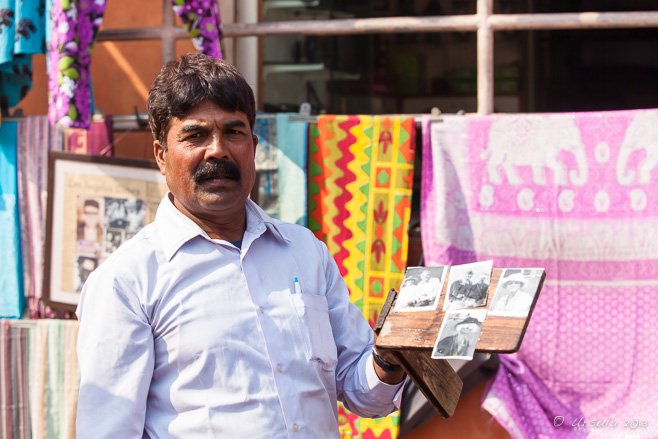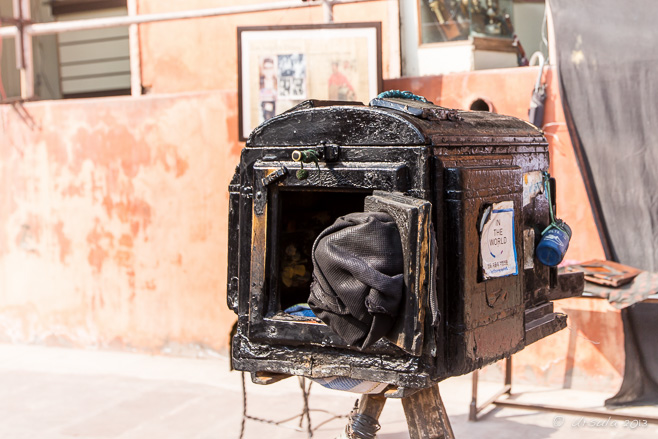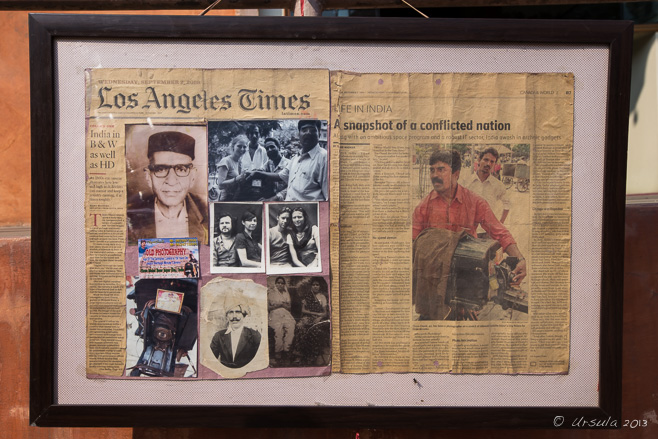
Mr Tikam Chand
Jaipur street portrait photographer.
When do two negatives make a positive?
When you are dealing with film – that tricky stuff that used to be in all our cameras. Every so often I come across a forgotten roll in a box somewhere, but I haven’t used it for years. Recently, however, I met a man who still shoots – and develops – film.
It was Jaipur. Mid-morning. Nine photography-enthusiasts were seated on a bus which was stop-starting its way through the crowded streets.
Photo-guide Karl Grobl and local guide DV – Digvijay Singh were at the front, alternating between conspiratorial whispers together and animated telephone conversations in Hindi. Finally, the good news: “We found him! He’ll see us.”
Somehow, our driver turned the bus around in the busy, narrow streets, and we tumbled out into the Hawa Mahal district of Jaipur with all our whiz-bang digital camera equipment in tow.
A short walk up a road with market shops on one side and street vendors on the other, and we found the “studio” of Mr Tikam Chand, grandson of the man who was the official Royal Photographer for the Maharaja of Jaipur in the 1800s.

The “Minute Camera”
The same 1860 Carl Zeiss wooden camera with its built-in dark room that took pictures of royalty during the Raj now takes tourist pictures in the street.

Clippings
Yellowing photos and news reports tell the story of the old camera and the two brothers, Surendar and Tikam Chand, who have operated it since it was passed down to them in 1977.

Street Photography
Travellers, with their digital cameras, take pictures of the 150-year-old camera while Tikam Chand talks to guide DV.

Setting Up
Mr Chand likes his customers to be seated perfectly: he is ready with a comb and mirror.

Checking Settings
Tikam Chand checks settings ‘under the hood’ while his portrait subjects wait patiently. Focus on the camera is adjusted by sliding the lens back and forth inside the wooden box.

Letting in the Light
Tikam Chand has a finely developed sense of light and time. The old camera has no shutter release; he simply removes the lens cap, counts off in his head, and replaces the cap.

Look into the Lens!
The aperture can be adjusted from 4.5mm to 32mm using a brass bracket around the lens.
The Jaipur street gets hotter as the mid-morning sun rises.

Jan and Lew
Two group participants smile for the camera…

The Wonder of Optics
… and their image inside the camera is upside down.

Measuring
When all the pictures are taken…

Pouring
… it is time to mix the developing chemicals.

Water Rinse
After their chemical bath, the negative prints get their water rinse.

Twine and Cracked Glass
The photo plates on the archaic wooden camera – reputedly the last of its kind in the world – are held together with twine. Cracked glass guards precious old photos.

Negatives
Negative prints are pinned up to be photographed to produce positive images…

Chemical Rinse
… and the whole development process is repeated.

The Exchange
A customer pays for her fresh prints – negative and positive. The package needs to stay covered in newspaper for thirty minutes or longer. Tikam and his brother are having more difficulty sourcing the appropriate paper and chemicals these days, so prices have gone up. We payed 500INR ($8) for each of our photo sets. Well worth it for the experience!
 As we count down the days, looking forward to the new year, it is worth looking back as well, back to how things once were, and to preserve the knowledge, skills, and traditions of the past.
As we count down the days, looking forward to the new year, it is worth looking back as well, back to how things once were, and to preserve the knowledge, skills, and traditions of the past.
For it is “the old way of doing things” that has given us something to build on.
Wishing you a Happy Holiday Season.
Photos: 15November2013




















.png)


Very retro in this digital age
Awesome story, awesome images, and told only as Ursula can do…I so enjoyed reliving every moment of that encounter in Jaipur through your words and pictures. Thanks Ursula for this holiday gift, you’re amazing! Happy Holidays, Karl
Awe, thanks Karl. I always look forward to those “unique” experiences that are always part of your trips. Happy Holidays!
I took my best family portrait with Mr Surendar in 2006. You can see a photo in my portfolio from India, photo 5 (http://luisduarte.com/eternal-india/).
My profile photo in facebook, is the one he took (https://www.facebook.com/luis.duarte.583).
Good memories, Thanks!